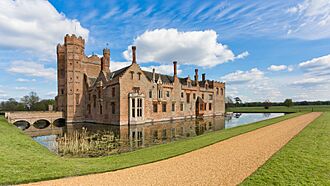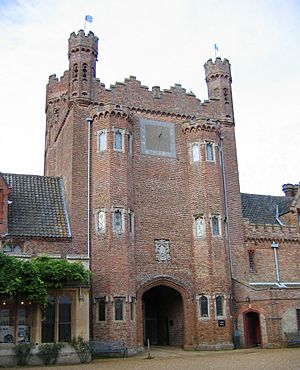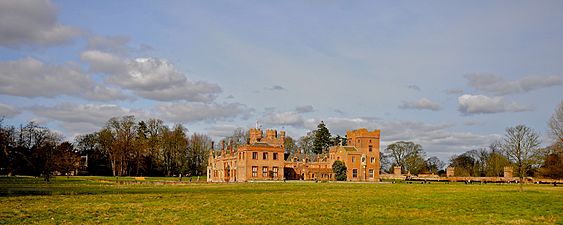Oxburgh Hall facts for kids
Quick facts for kids Oxburgh Hall |
|
|---|---|

Oxburgh Hall 2017
|
|
| General information | |
| Type | country house |
| Architectural style | Tudor |
| Location | In the village of Oxborough, 7 miles south west of Swaffham |
| Town or city | Oxborough |
| Country | England |
| Coordinates | 52°34′52″N 0°34′13″E / 52.5810421°N 0.5704133°E |
| Completed | 1482 |
| Owner | National Trust |
| Technical details | |
| Material | brick, stone and slate |
Oxburgh Hall is a beautiful old country house in Oxborough, Norfolk, England. It is surrounded by a moat, which is like a wide ditch filled with water. Sir Edmund Bedingfeld built the hall in 1482. He received special permission to build it like a castle.
The Bedingfeld family got the land in Oxborough in the early 1400s. They have lived at the hall ever since it was built. Today, the National Trust owns Oxburgh Hall. They took over in 1952. The house was greatly updated in the mid-1800s. This work was done by John Chessell Buckler and Augustus Pugin.
Contents
The History of Oxburgh Hall
Oxburgh Hall is a great example of a medieval house. It was built to face inwards, around a central courtyard. The house sits inside a square moat. This moat is about 75 meters (246 feet) on each side.
Originally, the house was completely enclosed. But in 1772, one side of the house was taken down. This made the house shaped like a "U," open to the south.
The Grand Entrance Gatehouse
You enter Oxburgh Hall by crossing a three-arched bridge. This bridge is on the north side. The entrance leads through a strong gatehouse. This gatehouse was built to show the owner's power. It has tall, many-sided towers on each side. These towers rise up in seven levels. The gatehouse is a very important part of the hall's design.
Changes Over Time
Around 1835, the open "U" shape of the house was filled in. This created a central courtyard again. Other changes were made in the Victorian era. These included new gables, which are the triangular parts of a wall under a sloping roof. A large tower was added to the southeast. New windows that stick out over the moat were also built.
In the 1830s, Sir Henry Paston-Bedingfeld asked two architects, John Chessell Buckler and Augustus Pugin, to restore the hall. They added a chapel. They also rebuilt the walled kitchen garden and flower gardens. A stable building for horses was added too.
Secret Hiding Places and Famous Needlework
Oxburgh Hall is famous for its priest hole. This was a secret hiding place. It was built by Nicholas Owen. The Bedingfeld family was Catholic. During a time when Catholics faced difficulties, they used this secret room. It was hidden behind a lavatory (toilet) to keep priests safe.
The hall also has the Oxburgh Hangings. These are beautiful pieces of needlework. Mary, Queen of Scots and Bess of Hardwick created them. Mary worked on these hangings while she was held captive in England.
Gardens and Estate
A large park was created to the south and west of the house in the 1830s. A formal French garden was laid out to the east of the moat. A lovely pleasure garden was also made to the west of the new chapel. The estate has many woodland paths. There is even a 'Woodland Explorer' trail for visitors.
Saving Oxburgh Hall
In 1950, Oxburgh Hall and its land were sold in pieces. The hall and gardens were almost torn down in 1951. But they were saved! Sybil, Lady Bedingfeld, her daughter Mrs. Frances Playford, and her niece Mrs. Violet Hartcup raised enough money. They bought Oxburgh Hall back. Then, in 1952, they gave it to the National Trust.
In 2021, the National Trust announced a new plan. They are changing 175 acres of farmland back into woods and pastures. This will help local wildlife. The project uses old photographs from an RAF survey in 1946. They are planting 227 trees to create new homes for animals.
Architecture and Design
Oxburgh Hall is a very important building. It has been given a Grade I listing on the National Heritage List for England since 1951. This is the highest level of protection. The hall's beautiful gardens are also important. They have been Grade II listed on the Register of Historic Parks and Gardens since 1987.
Gallery





